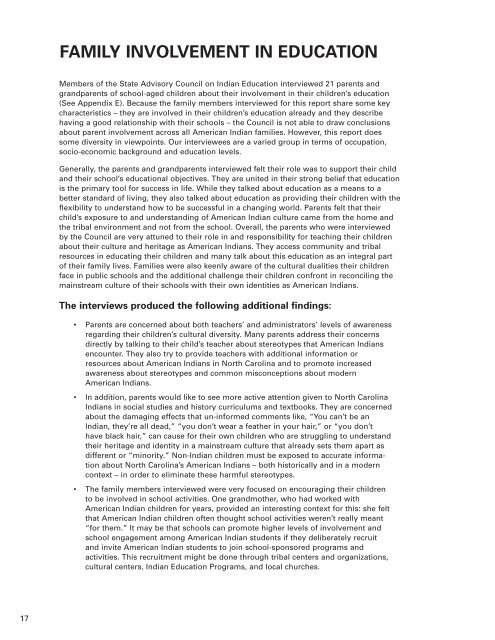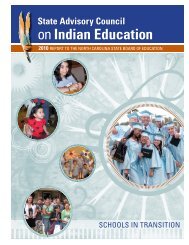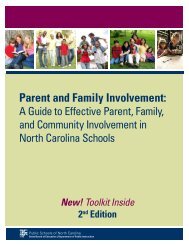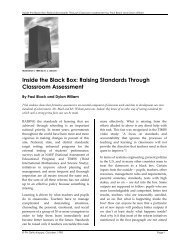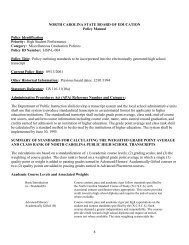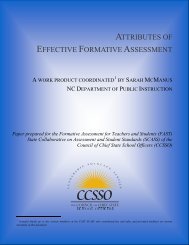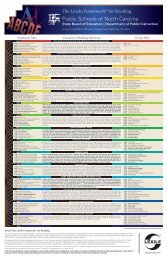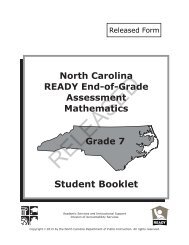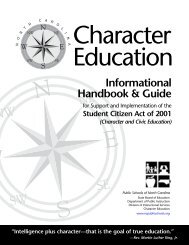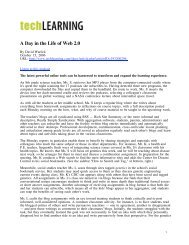pdf, 2.0mb - Public Schools of North Carolina
pdf, 2.0mb - Public Schools of North Carolina
pdf, 2.0mb - Public Schools of North Carolina
You also want an ePaper? Increase the reach of your titles
YUMPU automatically turns print PDFs into web optimized ePapers that Google loves.
FAMILY INVOLVEMENT IN EDUCATION<br />
Members <strong>of</strong> the State Advisory Council on Indian Education interviewed 21 parents and<br />
grandparents <strong>of</strong> school-aged children about their involvement in their children’s education<br />
(See Appendix E). Because the family members interviewed for this report share some key<br />
characteristics – they are involved in their children’s education already and they describe<br />
having a good relationship with their schools – the Council is not able to draw conclusions<br />
about parent involvement across all American Indian families. However, this report does<br />
some diversity in viewpoints. Our interviewees are a varied group in terms <strong>of</strong> occupation,<br />
socio-economic background and education levels.<br />
Generally, the parents and grandparents interviewed felt their role was to support their child<br />
and their school’s educational objectives. They are united in their strong belief that education<br />
is the primary tool for success in life. While they talked about education as a means to a<br />
better standard <strong>of</strong> living, they also talked about education as providing their children with the<br />
flexibility to understand how to be successful in a changing world. Parents felt that their<br />
child’s exposure to and understanding <strong>of</strong> American Indian culture came from the home and<br />
the tribal environment and not from the school. Overall, the parents who were interviewed<br />
by the Council are very attuned to their role in and responsibility for teaching their children<br />
about their culture and heritage as American Indians. They access community and tribal<br />
resources in educating their children and many talk about this education as an integral part<br />
<strong>of</strong> their family lives. Families were also keenly aware <strong>of</strong> the cultural dualities their children<br />
face in public schools and the additional challenge their children confront in reconciling the<br />
mainstream culture <strong>of</strong> their schools with their own identities as American Indians.<br />
The interviews produced the following additional findings:<br />
• Parents are concerned about both teachers’ and administrators’ levels <strong>of</strong> awareness<br />
regarding their children’s cultural diversity. Many parents address their concerns<br />
directly by talking to their child’s teacher about stereotypes that American Indians<br />
encounter. They also try to provide teachers with additional information or<br />
resources about American Indians in <strong>North</strong> <strong>Carolina</strong> and to promote increased<br />
awareness about stereotypes and common misconceptions about modern<br />
American Indians.<br />
• In addition, parents would like to see more active attention given to <strong>North</strong> <strong>Carolina</strong><br />
Indians in social studies and history curriculums and textbooks. They are concerned<br />
about the damaging effects that un-informed comments like, “You can’t be an<br />
Indian, they’re all dead,” “you don’t wear a feather in your hair,” or “you don’t<br />
have black hair,” can cause for their own children who are struggling to understand<br />
their heritage and identity in a mainstream culture that already sets them apart as<br />
different or “minority.” Non-Indian children must be exposed to accurate information<br />
about <strong>North</strong> <strong>Carolina</strong>’s American Indians – both historically and in a modern<br />
context – in order to eliminate these harmful stereotypes.<br />
• The family members interviewed were very focused on encouraging their children<br />
to be involved in school activities. One grandmother, who had worked with<br />
American Indian children for years, provided an interesting context for this: she felt<br />
that American Indian children <strong>of</strong>ten thought school activities weren’t really meant<br />
“for them.” It may be that schools can promote higher levels <strong>of</strong> involvement and<br />
school engagement among American Indian students if they deliberately recruit<br />
and invite American Indian students to join school-sponsored programs and<br />
activities. This recruitment might be done through tribal centers and organizations,<br />
cultural centers, Indian Education Programs, and local churches.<br />
17


